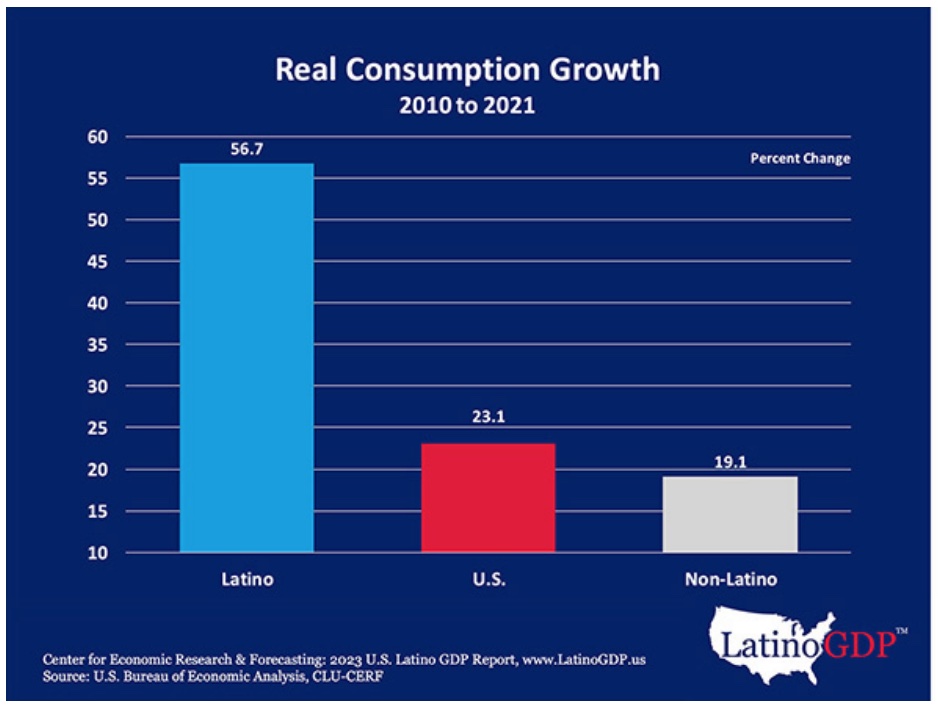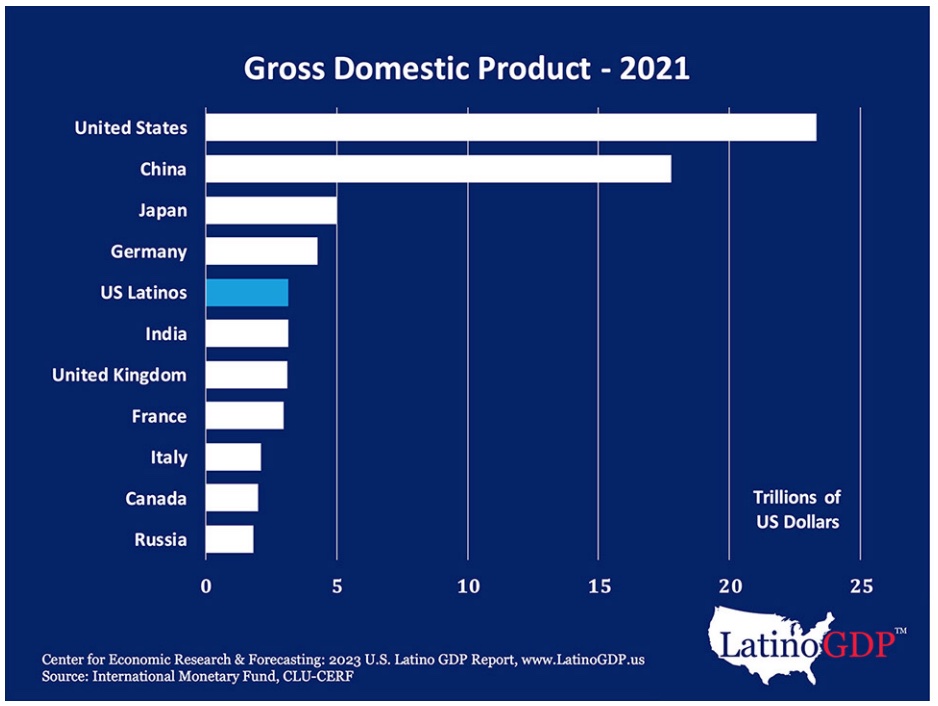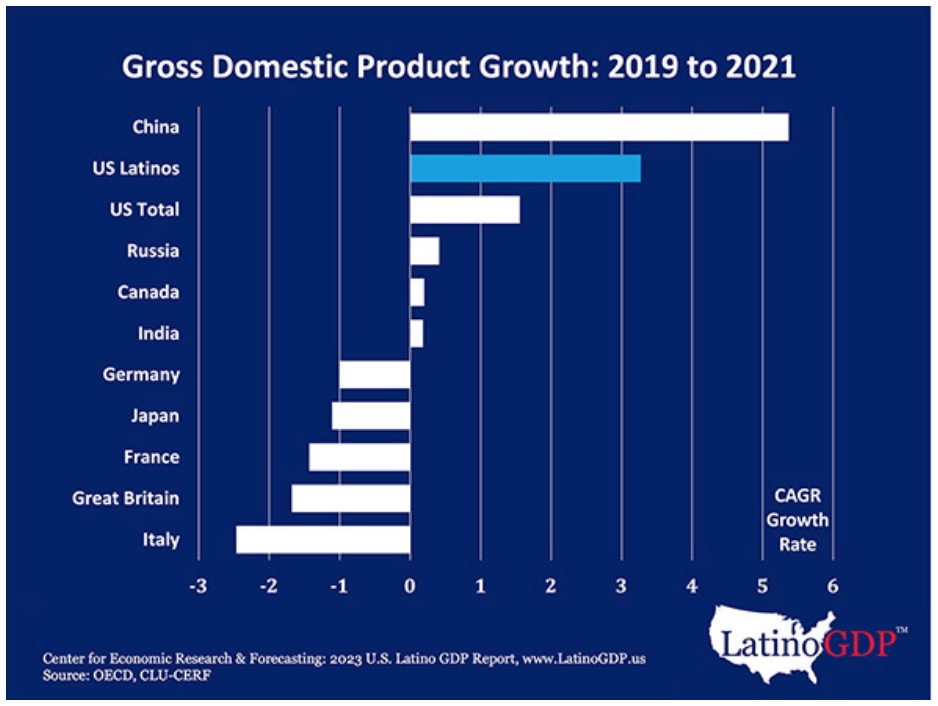One of the many misconceptions about the U.S. Latino community is that it is a drag on the country’s economy. But if U.S. Latinos were an independent country, they would be the fifth largest economy in the world, larger than India, the United Kingdom, and France.
Moreover, their economic growth in recent years is outranked only by China.
According to the latest U.S. Latino GDP Report, the total economic output of Latinos in the United States in 2021 totaled $3.2 trillion, representing the total amount of goods produced and services provided by Latinos of any background and immigration status in the United States.
“This is not the normal narrative of Latinos,” said Dr. David Hayes-Bautista, director of the Center for the Study of Latino Health & Culture at the UCLA David Geffen School of Medicine, which helped produce the report. “The normal narrative of Latinos is they come to live off welfare, steal jobs, and all that. That’s not the case. Latinos are the point of growth. This is where you want to invest if you want to see more GDP growth in the future.”
Latinos are the ‘point of growth’ for the US economy
This is the sixth year in a row that there has been a comprehensive paper looking at all the publicly available data from major U.S. agencies calculating U.S. Latino GDP. But it is a work of many years and the brainchild of Hayes-Bautista, who developed the original algorithm along with Werner Schink, former Chief Economist with the California EDD.
The latest report, co-produced by the Center for Economic Research & Forecasting (CERF) at California Lutheran University and economists Matthew Fienup and Dan Hamilton, shatters existing myths about Latino’s economic contributions in the United States.
One example: the GDP of Latinos in the U.S. grew at a faster pace than the national GDP from 2010 to 2021. The report also notes the Latino labor force was “an important source of resilience for the broader economy in 2021, despite a second year of COVID-19 pandemic conditions.”

In an interview with Ethnic Media Services, Hayes-Bautista argued that Latinos are the point of growth for the United States economy, both in terms of spending and labor. “If it weren’t for Latinos, the U.S. economy would be significantly smaller than it is today,” he said.
The researcher and his partners are now working on a second report that focuses specifically on the economic output of Latinas who – while “largely immigrant” and with lower rates of education – are a major component of this emerging trend.
Indeed, Hayes-Bautista believes we are just at the beginning of this growing market.
“Their children are entering the labor force, and there are three children for every Latino 60-year-olds, 90% of who graduate from high school, and two-thirds go to college. They are fluent, bi-lingual and citizens, so they are entering the labor force with much greater human capital than their largely immigrant parents did,” said Hayes-Bautista. “Imagine what they are capable of if we invest.”
Keeping the economy afloat during Covid
Latino GDP growth was 7.1%, a full two percentage points larger than growth among non-Latinos. Latinos also represent a formidable consumer market, larger than the entire economies of countries including Italy, Canada and Russia, which boast the world’s eighth, ninth, and tenth largest GDPs, respectively, and larger than the entire economy of states like Texas or New York.
Latino real consumption grew three times faster than that among non-Latinos.
Why is all of this happening? And why now?
“Well, Latinos consistently have had a much higher rate of labor force participation than non-Latinos,” said Hayes Bautista. “And when we look at the COVID years, 2020 and 2021, as it turns out, Latinos tend to work in jobs that they are less likely to be able to do by sheltering at home.”

A lot of the focus – and rightly so during those years and since – has been on the price paid by essential workers, many of them Latinos, for having to show up to work in the factories, the farms, the packing houses, and the stores, even as much of the workforce remained under Covid lockdown. However, according to Hayes-Bautista, Latinos not only kept everyone else fed and housed, but they kept the country afloat economically.
“Do you remember the first couple of months of the COVID shutdown in 2020 when people were fighting in the stores over rolls of toilet paper? If it weren’t for Latino farm workers going to work every day, they would have been fighting over the last sack of potatoes in the store. That would have been very serious,” he said.
Latinos paid the price, with higher Covid mortality and infection rates, he adds, but kept this country going.
“That’s bravery, that’s resiliency, that’s courage,” he noted.
Removing barriers to greater economic participation
In 2021, Latinos were six percentage points more likely to be actively working or seeking work than their non-Latino counterparts.
Latinos have also improved their overall economic output through rising educational achievements. The report finds that the number of people earning a bachelor’s degree grew three times faster for Latinos than non-Latinos.
Still, says Hayes-Bautista, the U.S. needs to invest more in education. He compared the experience of his son, who graduated from university ten years ago with substantial debt, to his own experience coming out of college debt free.
“Baby boomers like me got a free education. So why do we charge today for education that we got for free? This is one of the many issues, probably the major, affecting young people’s ability to buy houses.”
And even as homeownership rates among Latinos climbs, “we are not making it easy,” he added.
For Hayes-Bautista, the message coming out of the data is clear.
“Latinos are the future of the U.S. economy, and we are the last chance for this country to maintain economic preeminence throughout the 21st century.” He continued, “Imagine if we took away the barriers.”
Watch the full press conference along with presentations of the report’s findings.
Image via Unsplash






